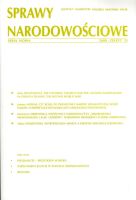The catholic church and the ustasha nationalism in Croatia during the second world war
The catholic church and the ustasha nationalism in Croatia during the second world war
Author(s): Irina Ognyanova-KrivoshievaSubject(s): History
Published by: Instytut Slawistyki Polskiej Akademii Nauk
Keywords: Catholic Church; religion; Catholicism; clergy; Independent State of Croatia; Nationalism; Ustasha regime; religious policy; Croatian Orthodox Church
Summary/Abstract: Although the connections between the Catholic Church and the Ustashas were lied down in the interwar period, they were developed in war-time Independent State of Croatia (ISC). The Ustashas claimed the new regime “guaranteed” freedom and “equality” of religion in Croatia, but they identified Catholicism with Croatism. Because of its national role in the Croatian history and traditional confrontation with Orthodoxy, the government saw in the Catholic Church a natural ally. In contrast to the last, which was tolerated by the state, the Serbian Orthodox Church was almost liquidated in the ISC and finally substituted by the Croatian Orthodox Church. With an aim of assimilation of Serbs, the Nationalists undertook a religious policy of their Catholicization in the country. But as an authoritarian regime, the Ustashas tried to subordinate the Catholic Church to their authority and that led to a profound conflict with the priesthood. After its bitter experience in Yugoslavia, the Catholic Church approved the creation of the sovereign Croatian state, but not the particular Ustasha rule. While the lower clergy was more adaptive to the Ustasha influence, the higher hierarchy stayed aside from the extreme nationalistic policy of the government. The Bishops defended the Croatian national interests, that is why they protested against the anti-Croatian policy of “allied” Italy and the German terror in the ISC. After the new government started a war against all “national enemies” in the country – Serbs, Jews, and Gypsies, the Church demonstrated its disapproval of this practice. It rejected the genocide of the Orthodox population and never approved the forced conversions. It was the institution that raised its voice against the policy of mass liquidation of the Jews in the ISC and openly condemned racism and racial discrimination. In its relationship to the authorities the hierarchy went through different stages of cooperation and confrontation. After the first phase of support, a period of deterioration followed, to reach at the end of the war a new phase of normalization. But the Archbishop was forced to maintain good official relations with the Ustasha regime, which was merciless towards all political opponents. The Catholic Church was in a privileged position in Croatia for the first time after 1918, and the regime was Croatian and pro-Catholic. The clergy stood for an independent Croatian state and did not lose hope that it would have a new legitimate regime after the end of the war.
Journal: Sprawy Narodowościowe
- Issue Year: 2008
- Issue No: 33
- Page Range: 7-26
- Page Count: 20
- Language: English

